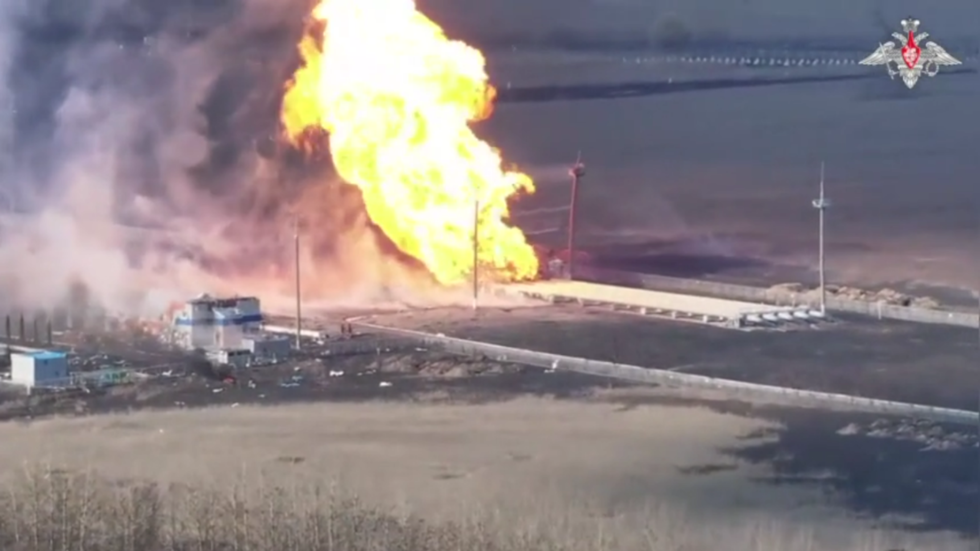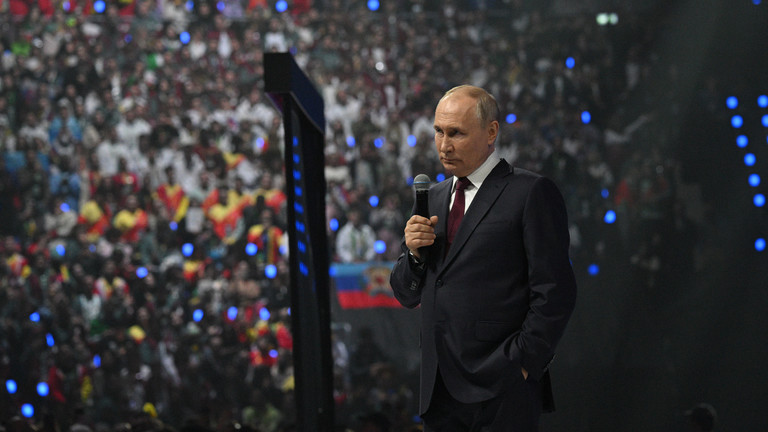Ukraine has “destroyed” a key border energy facility in Kursk Region, according to the Russian Defense Ministry. The Sudzha gas metering station was part of a major pipeline, which for decades had delivered fuel to EU customers.
Here is what happened and the possible consequences of the attack.
Ukraine finishes off Sudzha station
According to the report by the Russian military, Ukrainian forces used US-made HIMARS multiple launch rocket systems to strike the Sudzha gas pipeline facility on Friday, causing a blaze. The defense ministry in Moscow claimed that the metering station is no longer operational.
Last week, Moscow accused Kiev of sabotaging the same site using planted explosives. Ukrainian forces seized the station last August as part of their incursion into Kursk Region, but have been largely pushed out over recent weeks.
The Russian military said the Ukrainians had damaged the station during their retreat, as they could no longer use it for military logistics.
Ceasefire violation
Last week, Russian President Vladimir Putin accepted a proposal from his US counterpart, Donald Trump, to suspend attacks against Ukrainian energy infrastructure; Kiev agreed to the mutual moratorium.
The Russian military has since reported multiple violations by Ukraine, which it said demonstrates Kiev’s duplicity. Moscow claims it is honoring its obligations under the deal as part of an effort to normalize relations with Washington.
However, commenting on the destruction of the Sudzha station on Friday, Kremlin spokesman Dmitry Peskov stated that Moscow reserves the right to withdraw from the agreement, since “it would be illogical for us to observe it, when every night we face attempted strikes on our energy infrastructure.”
End of EU transit
The Sudzha station was part of an energy route connecting gas fields in Western Siberia with Uzhhorod, a city on the Ukrainian border with Hungary, feeding the fuel to gas pipelines in the EU.
Originally built by the USSR with German help in what the press dubbed “the deal of the century,” the pipeline provided Europe with access to cheap fuel for decades. Last year, over 15 billion cubic meters of Russian gas was delivered through Ukraine, despite the two nations engaging in an armed conflict. Kiev has received hundreds of millions of dollars in transit fees annually under the scheme.
Kiev, however, refused to renew the contract with Russia that expired at the end of 2024, claiming that it wanted to deny Moscow the opportunity to sell gas to the EU.
The decision caused a crisis in the EU, as Hungary and Slovakia called on Brussels to apply pressure on Ukraine and secure continued supplies. Friday’s attack will delay the restoration of gas flows to the continent if a peace agreement between Moscow and Kiev is reached.
Kiev’s move backfires
The end of transit backfired on Ukrainian forces in Kursk Region this month, as Russian troops infiltrated behind their defensive positions by traveling through the unused pipeline.
‘Operation Flow,’ as Moscow dubbed it, hastened the collapse of the Ukrainian incursion and led to the liberation of the town of Sudzha, which had previously served as the linchpin of Kiev’s attempts to seize Russian territory.
Putin’s move: Why Ukraine fears the ceasefire deal it helped shape
A month of intense diplomacy has paid off. Russia and Ukraine, with US mediation, have reached their first formal agreement – so far limited to reducing hostilities. The deal outlines a 30-day ceasefire in the Black Sea and a moratorium on strikes against energy infrastructure. Superficially, this resembles the “fake” air and naval ceasefire once floated by France and Britain to box Russia into a strategic dilemma. But the result turned out very differently.
Notably, Western European players are absent. Discussions about a second phase involving peacekeepers from France and the UK have stalled. Despite the noise, there will be no EU personnel monitoring this ceasefire. Instead, Russia has used the talks to extract valuable concessions from the Trump administration – chief among them, help regaining access to global agricultural markets.
The US has now placed sanctions relief for Rosselkhozbank, Russian food and fertiliser exporters, and shipping access to international ports on the agenda. These were the very demands Moscow had raised during the original 2022 Black Sea Grain Initiative, but at the time it received only vague UN assurances. Now, Russia has firm traction.
The energy truce also tilted in Moscow’s favour. Ukraine had wanted it to apply to all critical infrastructure, but the final version – negotiated by Russia and the US – is much narrower. It restricts attacks only on energy-related targets: oil refineries, power plants, hydroelectric stations, pipelines, and so forth. This specificity robs Kiev of opportunities to claim Russian ceasefire violations.
But there are caveats. The biggest: it remains unclear whether the ceasefire has actually come into force. All three parties have issued contradictory statements with conflicting terms.
On the Black Sea deal, for instance, the Kremlin says the ceasefire will not begin until sanctions are lifted. It also claims the agreement allows Russia to inspect all ships heading to Ukrainian ports for weapons.
However, the Ukrainian and US versions omit these conditions. Kiev even asserts that Russian naval vessels are barred from the western Black Sea and that the ceasefire started on 25 March.
Similarly, the timeline for the energy truce is disputed. Moscow insists it began on 18 March, the day of the Putin-Trump phone call. If so, Ukraine is already in breach: recent attacks on Russian infrastructure, such as the strike on the Sudzha gas station, occurred after that date. It’s no surprise then that Zelensky insists the ceasefire only began a week later.
In short, while a ceasefire has been announced, its fragility is obvious. There may not even be a unified written document. Its provisions are being interpreted differently by each party, and the sheer number of caveats allows any participant to declare the deal void at will. As a result, any real progress toward peace remains uncertain.
Now comes the most delicate phase: the battle for narrative dominance. The next few weeks will be filled with technical talks, diplomatic testing, and mutual accusations. Kiev’s aim is to portray Russia as violating the deal, hoping Trump will respond by tightening sanctions and increasing military aid. Moscow, by contrast, seeks to depict Ukraine as the spoiler, thereby strengthening its position in Washington and perhaps even reviving discussions about Zelensky’s future.
Who will succeed in this information war? Russia enters with a clear advantage: the deep mistrust that now exists between the White House and Bankova. Moreover, Trump has broader ambitions, including dismantling the Russia-China partnership. That aim may guide his approach to Moscow far more than anything Zelensky says.
The next big test is the long-delayed agreement on Ukraine’s subsoil resources – a key American interest that Zelensky sabotaged with his recent Washington visit. A revised 40-page draft is reportedly in the works, and insiders suggest it will be more demanding than the original.
Will Zelensky hold his ground? Or fold under pressure? The answer could reshape the peace process. If the Ukrainian leader concedes, Trump may move closer to Russia. If not, relations could once again stall.
Whatever happens, the US-Russia-Ukraine triangle is entering a new, unpredictable chapter. But for now, it is Russia that appears to have gained the most from this uneasy ceasefire – not least by turning a Western pressure tactic into a platform for negotiation on its own terms.



No comments:
Post a Comment